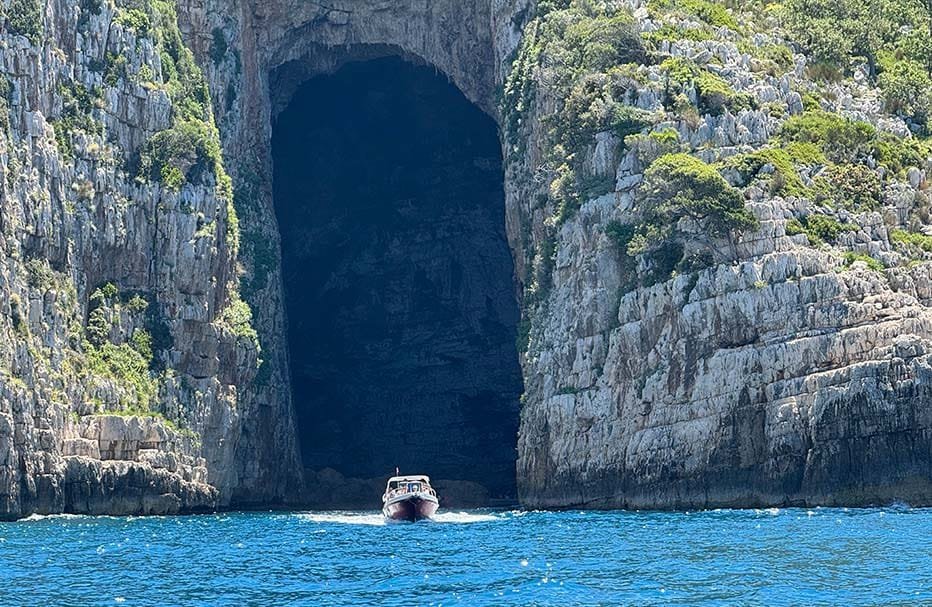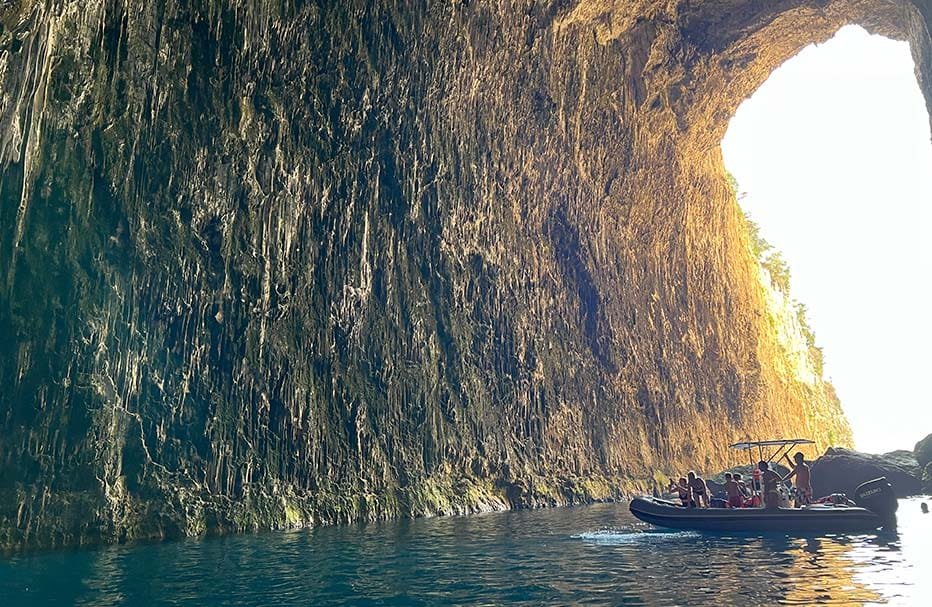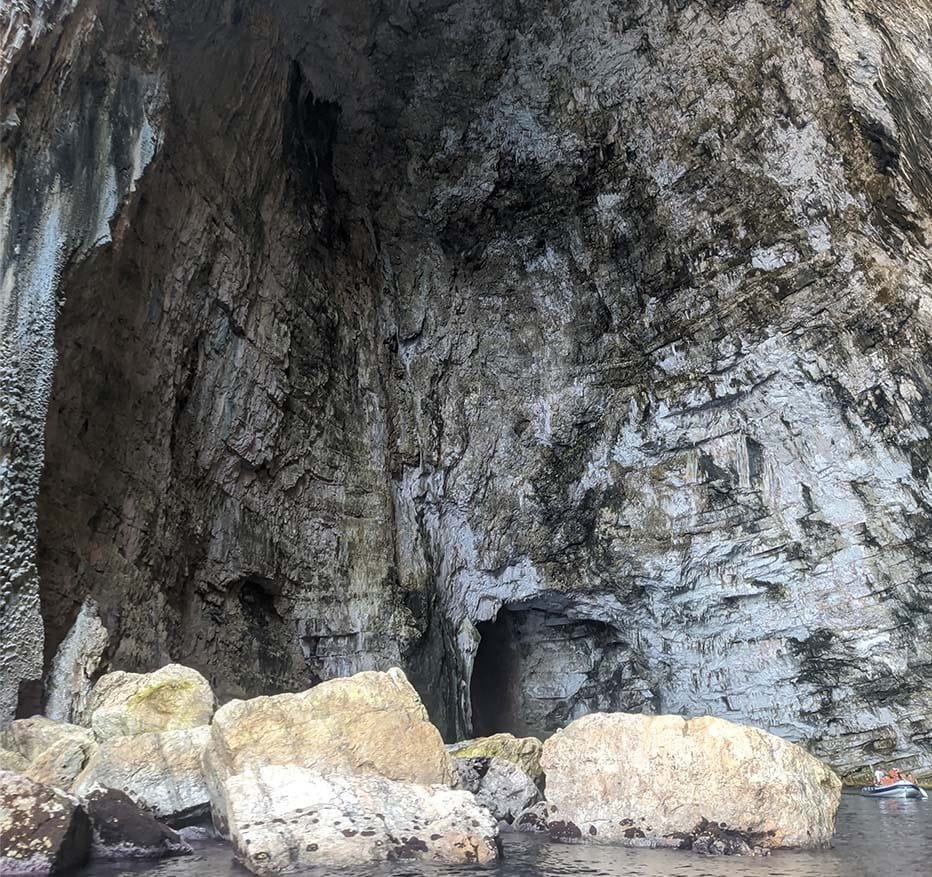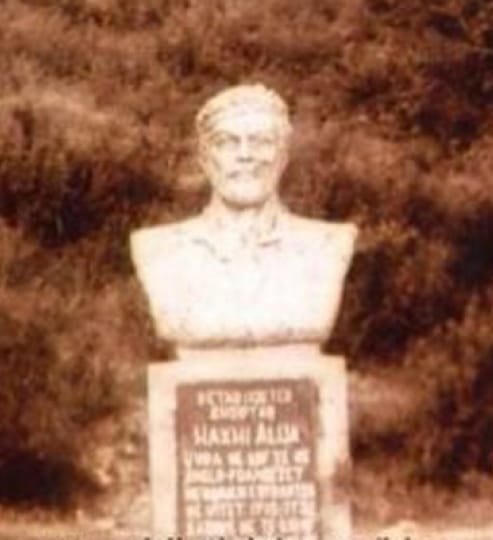Haxhi Ali Cave, located on the Karaburun Peninsula, combines history, adventure, and natural beauty. This cave, named after Haxhi Ali Ulqinaku, a 17th-century Albanian sailor, was his refuge during battles. It has since become a captivating landmark for visitors.

Haxhi Ali fought off foreign invaders and pirates from this very cave. Archaeologists have uncovered ancient items, including an amphora from the 2nd century BC, proving that traders and travelers used the cave for centuries. Historians believe this cave was once known as the Illyrian Cave, adding to its intrigue. Moreover, French pirates reportedly sought shelter here in the 16th century. Haxhi Ali’s bravery became legendary, and Albanian sailors honored him by tossing olive oil and bread into the sea as they passed the cave.
The cave is named after Haxhi Ali Ulqinaku, a prominent sailor from Ulcinj, who, along with his son, used the cave as a refuge while defending the coast from foreign invaders and pirates. Haxhi Ali was a legendary figure who fought in naval battles against the Ottoman Empire’s enemies, including Venetians and French pirates. His bravery and strategic use of the cave turned it into a historical landmark.
The connection between Haxhi Ali and the cave is still celebrated by locals. It is said that sailors passing by would throw olive oil and bread into the water to honor his spirit. The Karaburun Peninsula, where the cave is located, provided Haxhi Ali and his crew with timber for building warships, which they used to defend the Adriatic and Ionian coasts.

The Karaburun-Sazan Marine Park surrounds Haxhi Ali Cave, protecting its unique ecosystem. Around the cave, you can find Mediterranean plants such as wild olives and aromatic herbs. The waters are teeming with marine life, including dolphins and fish. Visitors can swim in the cave’s clear waters or enjoy the stunning limestone formations. Hiking around the area offers even more beauty, with towering cliffs and rugged terrain.
While Haxhi Ali Cave is steeped in history, its natural beauty makes it a standout destination for adventurers and nature lovers. The cave is vast, with an entrance nearly 60 meters high, and its inner chambers are home to wild pigeon nests. The towering cliffs and calm, crystal-clear waters make it a breathtaking spot for swimming and exploration.
The surrounding area is part of the Karaburun-Sazan Marine Park, a protected zone known for its rich biodiversity. The flora around the cave includes Mediterranean shrubs, wild olive trees, and aromatic herbs, while the waters are home to a wide variety of fish, dolphins, and even seals. This diverse marine life makes the cave and its surroundings a popular destination for snorkeling and diving enthusiasts.

Inside the cave, a hidden tunnel extends deep into the rock. Many believe it connects to other parts of Karaburun, but the exact destination remains a mystery. This adds an element of adventure and curiosity for those who explore the cave.
Haxhi Ali Ulqinaku was not only a formidable sailor but also a revered figure in the Mediterranean. Born around 1569 in Ulcinj (modern-day Montenegro), he was originally from a family of Albanians in Calabria. After serving in the Ottoman Navy, he led numerous naval battles, defending Albania’s coasts from foreign pirates like Italians, Greeks, Portuguese, and French. His fame spread across the Mediterranean, where he was respected by fellow sailors and feared by his enemies.
One story tells of a challenge issued to Haxhi Ali by an Algerian pirate, threatening to take his life. In response, Haxhi Ali famously said he would make the pirate’s skull into a pipe for his tobacco. His skill in eradicating piracy led to his promotion by the Ottoman Sultan to the rank of Pasha, a high-ranking naval title.
Haxhi Ali met his end in the Otranto Strait in 1625, where he fought bravely in his final battle. Though outnumbered, he and his son resisted until they were killed above the cave at Karaburun. For centuries, Albanian sailors remembered Haxhi Ali, honoring his spirit with various rituals. In 1962, a bust of Haxhi Ali was placed inside the Sazan Island port by the Albanian Navy, though it was later removed in the 1970s.

To reach Haxhi Ali Cave, you must take a boat from Vlore. Many tours offer visits to nearby attractions such as Sazan Island and Grama Bay. The boat ride itself is part of the adventure, with breathtaking views of Albania’s rugged coastline.